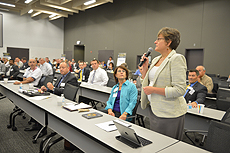More than 150 attend second joint Argonne-Fermilab small-business fair
 |
| A small-business owner raises a question at last week's Argonne-Fermilab small-business fair. Photo: Wes Agresta, Argonne National Laboratory |
What do you call more than 150 local small-business representatives in one room, forging connections with two national laboratories? If you're the organizers of the "Doing Business with Argonne and Fermi National Laboratories" small-business fair, you call it a good start.
On Thursday, Aug. 28, Illinois' two national laboratories — Argonne and Fermi national laboratories — joined forces for the second year in a row to host their popular small-business fair. Held at Argonne's Theory and Computing Science Building, the fair is an effort to reach out to local small businesses and startups and let them know about opportunities available to them.
That includes subcontracts as well as technology transfer and grant opportunities. This fiscal year to date, both labs have spent a combined $505 million in total procurements with the private sector. Of that $505 million, 46 percent, or more than $230 million, has gone to the small-business community.
Both laboratories have strong track records, but both want to continue reaching out to the business community.
The annual business fair is one way the labs are accomplishing this. Described by organizer Lee Zachos, Argonne's small business program manager, as "one-stop shopping" for local business owners, the event included sessions on bidding for contracts, working with technology transfer departments and establishing contacts at both laboratories.
During an opening presentation, Argonne Laboratory Director Peter Littlewood highlighted the laboratories' significant impact to the local economy.
"Our scientific facilities combined create and support nearly 1,000 jobs throughout the state of Illinois," Littlewood said. "Last year, the combined total of Argonne and Fermilab's economic output in Illinois was more than $1 billion."
Fermilab Deputy Director Joseph Lykken also mentioned the Illinois Accelerator Research Center, a new Fermilab endeavor that will offer further partnership opportunities to local businesses once it opens next year.
"It is our connection to local businesses that make these projects possible," Lykken said.
This year's event included a session featuring success stories from last year's inaugural fair. Representatives from five local businesses shared their experiences working with both Argonne and Fermilab, discussing various partnership opportunities they pursued with both laboratories after attending the first event last August. Also in attendance were U.S. Representatives Tammy Duckworth (8th District) and Mike Quigley (5th District), along with Patrick Doggett, a field representative for Rep. Adam Kinzinger (16th District).
The response to the small-business fair has been overwhelming, according to organizers, and there is already a waiting list for next year's event. Argonne and Fermilab plan to continue these fairs on an annual basis.
—Andre Salles
|